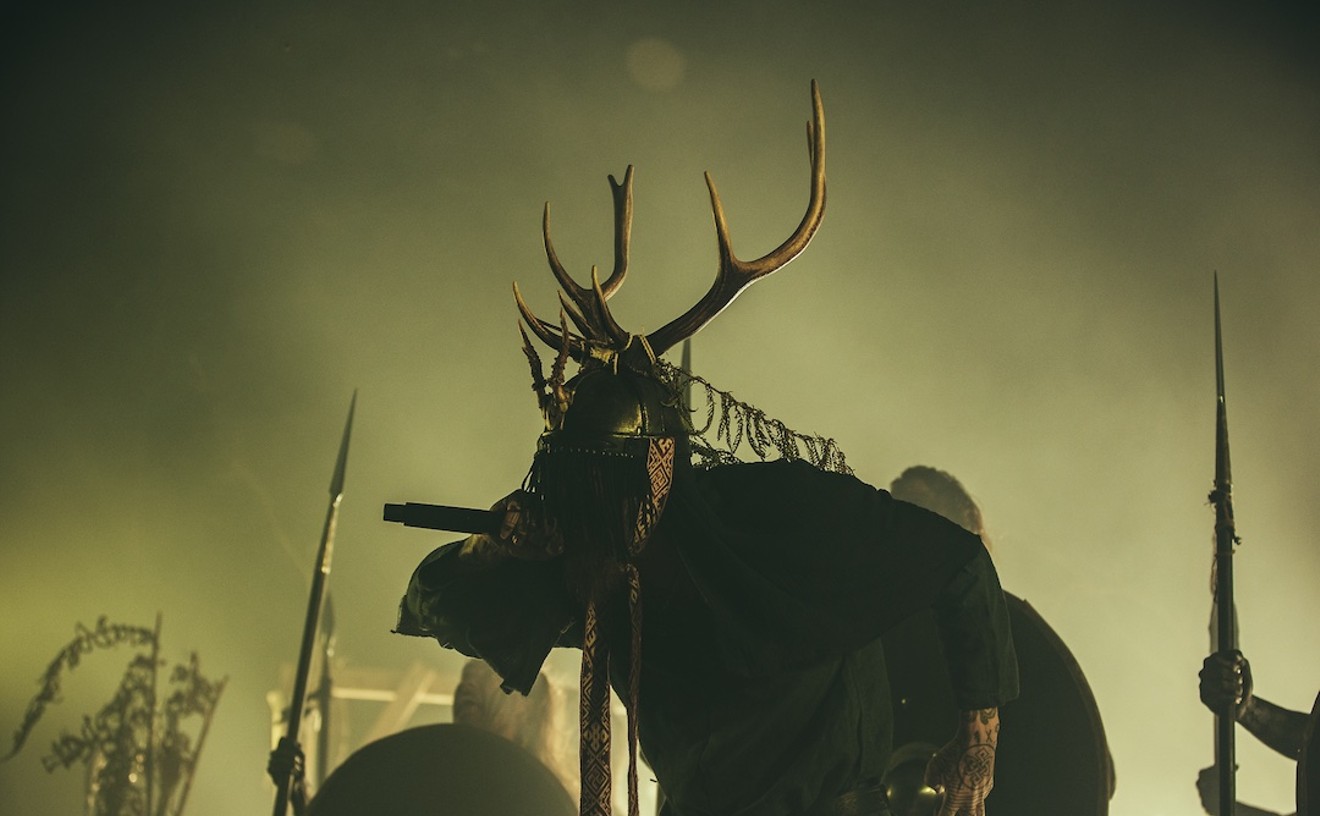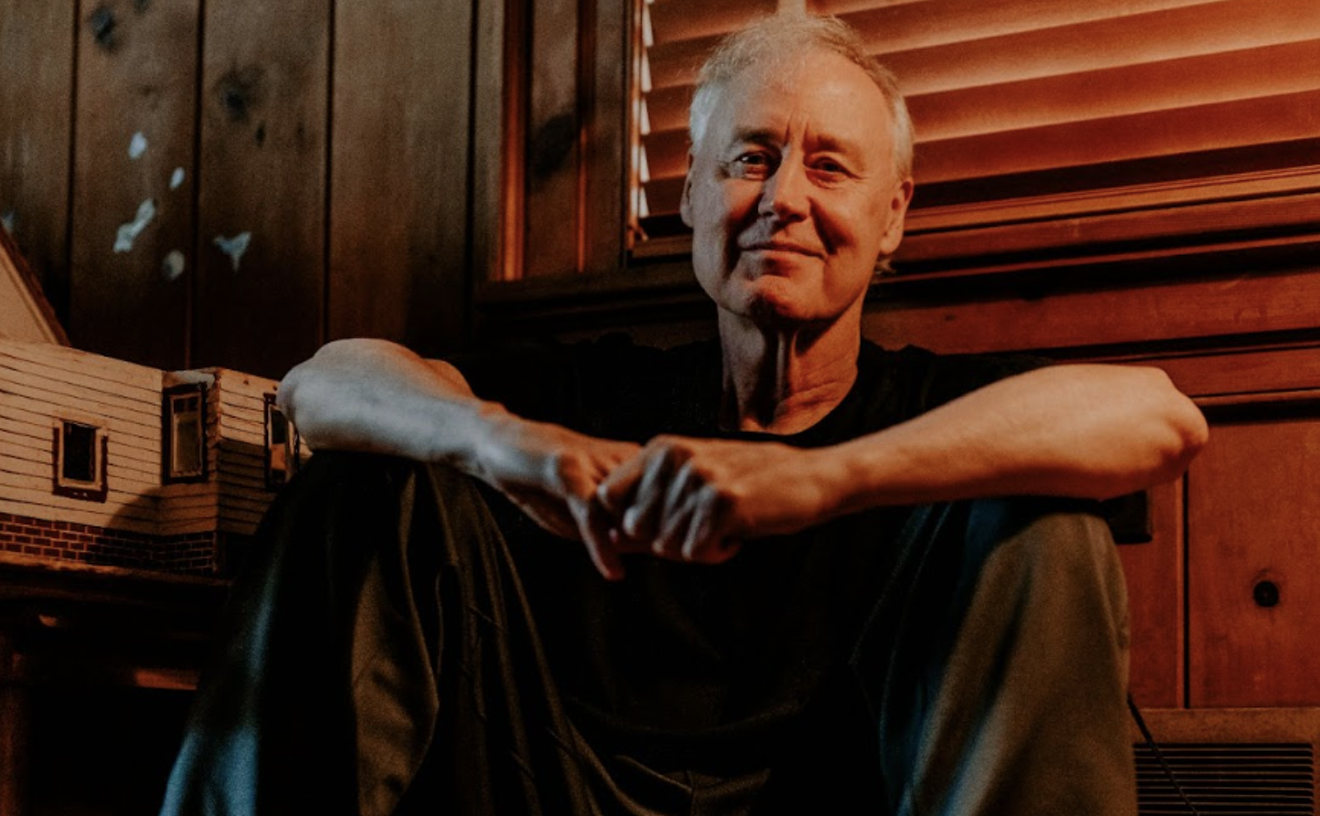Dizzy Gillespie, perhaps tired from a long night of gigging, mistakenly sat on his trumpet, causing the horn's normally straight bell to twist skyward at a perfectly right angle. Desperate to continue with the next set, Diz blew anyway, and the sound was good. Very good. Soon thereafter, the 45-degree trumpet was officially born.
Denver-based jazzman Sam Bivens knows a thing or two about the trumpet. He's been playing it since his friend Boots persuaded him to join a school band, sometime way back in 1945, when Bivens was a twelve-year-old boy living just outside of Knoxville, Tennessee. Back then, Bivens used to get a sly thrill out of riling up his father's hunting dogs -- all forty of them -- with his amateur blowing. And in every day that's followed, Bivens swears he's laid his hands on the horn for at least a little while; practice, he contends, makes perfect. It's something you just don't have to tell a real musician.
So when he's asked about the origins of the strangely angled horn -- his primary instrument of choice as the bandleader of the twenty-piece Denver Jazz Orchestra, which he started in 1987 after moving here from Minneapolis -- Bivens tells the story a little bit differently. The 45-degree trumpet, he contends, comes not from a seating accident involving one of the world's most beloved blowers, but from a careful study of jazz as science.
"The 45-degree trumpet was designed by a committee of five of the world's greatest trumpet teachers, players and designers," says the 69-year-old Bivens. "The Martin company began manufacturing them. Dizzy had them in his trumpet section. Guys like Lee Morgan played them. They were designed to have the most perfect balance; they were best able to execute style. The straight trumpet will always be there, but the 45-degree trumpet is something a little bit...special."
It's easy to accept this scenario and, for that matter, any other story Bivens presents, as God's Honest Truth. He is a large man, with eyes that have seen some things -- they're steady and intense, but friendly. In quiet moments, he looks almost like a cutout from a textbook on the Big Band era -- an image peeled off the sleeve of all those thick LPs from Decca, Blue Note, Muse. Maybe it's the impeccably pressed navy-blue three-piece, Bivens's ever-present "gig suit," that invites this reverence and suggests the formality and ritual of an era long past -- an era when Benny Goodman, Count Basie and Duke Ellington ruled the radios and record players of many American households. Or it could be the simple fact that he's been there.
"I am an old-world musician, a traveler and an eternal optimist," Bivens says. "I was around with Basie. I've seen Ella Fitzgerald, Duke -- all of the greats. And I'll tell you what: In order to make it as a musician back then, you had to know the fundamentals. There was a certain level of musicianship expected. Players today don't seem to care about learning basic skills -- the kids in rock and hip-hop, they do not know writing, or arranging, or rhythms, or colors or transposing. It's like the whole world is lackadaisical, and that was not the way it was back then."
This is the way it was for Bivens back then: At twelve, his pal Boots introduced him to the grade-school band teacher, who asked what he would like to play. The saxophone? Nope, said Bivens, he didn't think he had enough hands to handle all those keys. "I looked at the trumpet and decided I'd pick this thing with just three little buttons. The people said to me, 'It'll take you thirty years to learn how to play this thing.' But I'm twelve -- what did I care about thirty years? I had no idea I was picking a monster."
That monster eventually led Bivens to a traveling gig with the Les Hines Orchestra. At age fourteen, he dropped out of the tenth grade and hit the road with a band of jazz pros, all of whom were significantly older. "I was fascinated by music. I played every day. Out on the road with them players -- they called me 'Little Boy' -- I wasn't worried about my age or their ages. I learned everything, played with the best."
From that time until he quit touring and moved to Miami in the early '50s, Bivens played trumpet with many of the greats of the era, like Nat "King" Cole, the Count Basie Orchestra, Jackie Wilson, Christine Chapman, Oliver Nelson. Precocious as he may have been -- sitting in with Cole before he was old enough to drink or drive -- Bivens regards the experience as both an education and a necessity.
"People have a lot of the wrong ideas about a working musician," he says. "It wasn't like it is now. People didn't think, 'Oh, a touring, working musician. That's all about getting drunk, or girls, or pills, or acting crazy.' For us, it was a job. There were touring bands all over the place -- the Brownskin Players, the Sweethearts of Rhythm, the Billy Eckstine Orchestra, the Lucky Miller Orchestra. You didn't think, 'Oh, this man I'm playing with is a great or famous man.' You thought, 'I am playing with a bunch of musicians, and let's find the highest level of quality and continue on.'"
Bivens eventually returned to school in Tennessee and joined more bands; one combo, the Jazz Giants, was the first racially mixed band allowed to perform at the University of Tennessee. Next came a call from the Army -- Uncle Sam, apparently, needed buglers as badly as he needed muscle in the Korean war, and Bivens was drafted into the Band Training Unit at a base in South Carolina. The trumpet served him well there: He was eventually appointed the Post Bugler for the generals and high-ranking officers on base. During this time, the monster known as his trumpet might also have saved his life.
"We were told that we would have to audition for the Army," he says. "Those who flunked the audition were sent to a rifle team and shipped on over to Korea. Those who passed it would be restationed to a little base way out in the desert of California. I didn't want to be in the war, but I learned all that war stuff, stayed in shape. But my mind was always on music, and I figured, 'Why go if you can stay?' Six of us auditioned, and six of us passed. We went on out to California, and I was back making music in a minute."
After the Army, Bivens kept moving. He went to New York City, a place he's since left and returned to "more times than I count." Over the years, he worked on The Jackie Wilson Show and as an arranger for the Bill Cratz Copying Service, a company that provided sheet music for ABC, NBC and CBS. ("A couple of wrong notes -- you're fired," Bivens recalls hearing his employer say.) He performed in a combo with Charlie Parker's pal, saxophonist Sonny Stitt (Bivens appears on the combo's recording Four Jacks and a King, which was released by Muse and "snapped up in two weeks"), and with Billy Taylor and Jazz Mobile. In 1981, Bivens moved to Minnesota to be near his family, then to Denver, where his daughter lives and runs a small business. In 1987 he formed the Denver Jazz Orchestra, both to satisfy his own need to play and to create a job for himself.
"When I first came to Denver, I found it a little bit hard to find work," he says. "Players here were a little bit cliquish. They were afraid of excellence. So I decided to get the Denver Jazz Orchestra together, and I went looking for the very best players I could find. I went from nightclub to nightclub to nightclub searching for the best, and I've found them. Just like water finds its own level, I wanted world-class."
Late last year, Bivens and the DJO began demonstrating their old-world prowess at Turk's Supper Club, an antique Denver establishment tucked in an unlikely neighborhood at 43rd Avenue and Fox Street. It's an area populated by Mexican taqueras and warehouses, some abandoned, some still in use. Railroad tracks intersect main roads; one line simply ends without warning in the middle of a street. Turk's is, by all appearances, a friendly, low-key watering hole, an after-work refuge for folks who live or work in the gray, industrial district. Six nights a week, the club's menu and decor is matched by its musical fare: Images of lovely Latinas and tricked-out cars flank the wood-paneled walls, while mariachi combos play for the largely Hispanic crowd dining on cheap taco plates and drinking Bud from bottles. Three months ago, Freddy Rodriguez, the celebrated local player who's held a chair in the Denver Jazz Orchestra since its inception, suggested that owner Willie Ray let the DJO use the space for weekly rehearsals. Turk's was soon reborn as a jazz club -- on Monday nights, at least.
According to Ray, who purchased the club in 1997, the transformation is befitting Turk's vibrant history. The restaurant, he says, has been open for more than eighty years and holds one of the oldest liquor licenses in the city. Al Capone used to hang out there, he swears, and at one point, Turk's was a music venue to rival any going today, including El Chapultepec, the celebrated jazz venue owned by Ray's friend, Jerry Krantz. ("I love him, but he doesn't know shit about music," Ray says jokingly of Krantz.) Turk's most notable moment in the spotlight might have come in 1973, when the place showed up in scenes of Scarecrow, a film starring Gene Hackman and Al Pacino.
These days, those who wander into the establishment on a Monday night expecting jukebox fare or a roving Spanish-style guitar player are in for an almost surreal surprise. On the floor, pool tables are cleared and jammed into corners to make room for Bivens and his very large band -- on most Mondays, it includes four alto saxes, five trumpets, drums, a keyboard, a stand-up bass, four trombones and at least one vocalist, slightly crammed together in a semi-circle underneath the club's dim hanging lamp. Most of the players set their massive stacks of music -- the orchestra has a repertoire of more than 162 songs -- on old-fashioned metal bandstands painted white and emblazoned with the letters DJO. At Bivens's cue, they go riffling through the sheets, trying to find the next piece before he counts down to the start of a standard, or something he's arranged, or possibly a piece written by one of his students -- he's taught more than 300 -- who's gone on to become an arranger herself.
Bivens is the only one to wear a "gig suit," a fact he laments. "I prefer classy people," he says. "Denver is much, much different from New York. In New York you pay $25 to get in the door, you do not want to look at some guy's dirty shoes. Here you can see the Denver Jazz Orchestra for free, but that doesn't mean it shouldn't be an elegant event." Yet the bric-a-brac appearance of the orchestra -- which regularly plays hotels, parties, weddings, conventions and community events -- is more a result of the ongoing search for the very best local players (hence the transient nature of its members) than a collective lack of good taste.
Of the DJO's original players, only a handful remain, Rodriguez, Al Hermans, Cam Martin and singer Gloria Holliday among them. Players come and go, get hired elsewhere or move away. But there's rarely a chair empty for long. These days, Bivens says, he's even managed to find a player in the rare odd young person who takes the time to actually study music theory. "The younger people coming to DJO have good taste, and they want to be with the best, just like the other players," he says. "In the DJO, you'll find all types: There's a tremendous number of Ph.D.s, airline pilots -- there's an RTD boardmember. People who are musically inclined seek this out."
At the foot of it all is Bivens, conducting and even dancing a little, his mouth moving almost unconsciously, uttering words like "zap!" and "pop!" as the horns hit, as the melodies kick in. When Bivens smiles, the players smile back. They watch him like children inhaling the simple movements of their parents.










